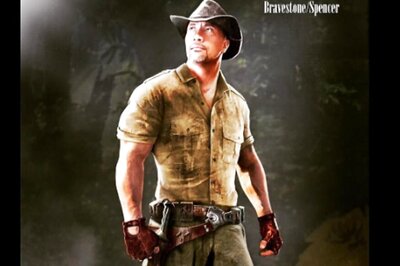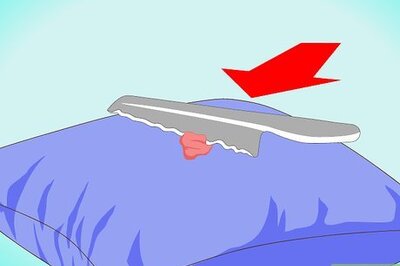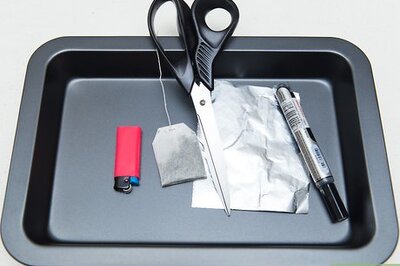
views
Katana
The katana is a long sword with a curved blade preferred by samurai. Samurai were a class of warriors who ruled over Japan from the 12th century up until the 1800s and the Industrial Revolution. While they primarily used a bow in combat, they wore long swords called katanas on their belts for self-defense from around the 15th century onward. A katana blade typically measures 2 ft (0.61 m) in length and has a slight curve to it, making it one of the most recognizable swords in the ancient Japanese armory. Samurai traditionally wore katanas with the sharp edge facing up.
Chokuto
The chokuto is a straight sword used before curved blades took over. Curved swords like the katana and the tachi weren't always the most popular in ancient Japan. Beginning in the Kofun period (300-710 AD), the Japanese made swords with straight, single-edged blades called chokuto. Even though straight blades were quicker and easier to make than curved ones, by the 13th or 14th century, swordsmiths had all but abandoned them to make katanas, which were sharper.
Tachi
The tachi is a long, curved sword that samurai carried before the katana. Before the samurai started carrying katanas, they carried tachi. These swords also had curved blades, but they extended up to 3 ft (0.91 m) in length as opposed to the katana's 2 ft (0.61 m). In the 15th and 16th centuries, the tachi was mostly replaced by the katana because it was shorter and better suited to close combat. Unlike the katana, a tachi was worn with the sharp edge facing down. Did you know? A tachi wielded by a famous Japanese warrior and feudal lord (daimyo), Fukushima Masanori, in the 16th century sold at auction in 2021 for $100 million! Masanori participated in a well-known conflict called the Battle of Shizugatake. There, he took first blood (i.e., was the first person to wound or kill someone else), which was a great honor in his culture.
Wakizashi
The wakizashi is a short sword that was worn on a belt with a katana. Samurai traditionally carried 2 swords: the katana and the wakizashi. The latter's blade is only a little under 1 ft (0.30 m) long, and samurai wore it whenever they were inside. This makes sense because indoors, there's even less room for close combat than there is on a battlefield. A Japanese warrior would traditionally carry his sword from his belt with the sharp edge oriented upward.
Osuriagi
An osuriagi is a sword with a shortened and remounted blade. This was a fairly common practice in feudal Japan. For example, a samurai might have shortened a tachi's 3 ft (0.91 m) blade to 2 ft (0.61 m) to use it as a katana. The only downside was that it sometimes cut off the swordsmith's signature, making it harder (if not impossible) to tell who originally crafted it. Did you know? From roughly the late 12th century to the 19th century, Japan was ruled by a feudal system, a system of government that divides people into classes based on their occupation. The emperor, the shogun (the country's military leader), and the daimyos ruled at the top. Next came the samurai, then farmers and peasants, artisans, and lastly, merchants.
Tanto
A tanto is a dagger that was the samurai's last weapon of defense. Samurai carried the tanto along with their swords, but they typically didn't use it in combat unless they had run out of options. A dagger has a short blade that ranges from 7–15 in (18–38 cm) in length. This makes it almost the same size as a wakizashi, but you can easily tell the difference because the tanto doesn't have a handguard. What's the difference between a dagger and a knife? A dagger is similar to a knife, except the blade is double-edged, and the 2 edges come down to a single point at the end. This makes it a more effective weapon than a knife, which only has one edge and is better suited for cutting and hacking than stabbing.
Naginata
The naginata is a polearm sword used by samurai and warrior monks. This unique weapon features a curved blade fixed to a long pole. Its first recorded use was in 1146 and was in common use by samurai for centuries. However, by the Edo period, it became mostly a trophy weapon and a class symbol displayed by Japanese women.
Yumi
The yumi was a Japanese longbow and the samurai's primary weapon. Yes, you read that right! Samurai used a longbow more than they used the katana, even though we associate them more with swords. This weapon was called a yumi, and could be up to 7 ft (2.1 m) long! Samurai mostly used them on horseback in a type of Japanese archery called Yabusame. It has more curves than an English longbow, which you might remember seeing in depictions of Robin Hood or medieval English knights.
Kabutowari
The kabutowari is a short blade for breaking helmets and stabbing armor. Its name literally means "helmet splitting" in Japanese, although some sources say that its primary purpose wasn't that dramatic. It came in 2 basic styles: a pointy blade for piercing in between pieces of armor, and a blunt, heavy blade that could dent or break the armor. They were typically around 14–18 in (36–46 cm) in length, and were used in close combat by samurai.
Tessen
The tessen is an iron weapon that resembles a Japanese folding fan. This is by far one of the most unique weapons crafted in ancient Japan. It consists of an iron frame that folds up or a single, solid piece of metal. When folded, it tucks neatly into a sash where it's handy. Samurai would turn to this weapon in close fights when they needed to deflect their opponent's strikes or throw something at them in self-defense.
Kusarigama
A kusarigama is a complicated weapon with a sickle at one end. The sickle is attached by a chain to a weight at the other end. Its unique design would allow a Japanese warrior to throw it at an enemy, tangle them up in the chain, and weigh them down with the weight. Then, the warrior could pull their opponent close by the chain and use the sharp, curved blade of the sickle end to maim or kill them.
Shuriken
A shuriken is a throwing weapon that includes knives and ninja stars. Regardless of its shape, which could be a spike or a star, a shuriken always had a small but deadly sharp blade that could cut through an artery as easily as paper. Samurai carried them for close combat, but so did ninjas. Ninjas were mythical, silent warriors whose legend rose to popularity in Japan at the beginning of the Edo period (1603-1867). The discreet shuriken blades were the perfect weapon for a martial artist known for sneaking around rooftops and fighting their enemies hand-to-hand. Wow your friends and practice your ninja skills by making homemade ninja stars.
Kama
A kama is a scythe that likely evolved from the tool into a weapon. A kama is a stick with a curved blade on the end. The stick can be long or short, and the short kamas can be wielded two at a time. This weapon was once simply a tool used by Japanese farmers to cut their crops. But, according to some sources, those same farmers repurposed them as weapons when the samurai that ruled over them confiscated all their other weaponry. The kama can deflect and disarm swords like katanas, as well as deliver a killing blow with its sharp tip.
Kiseru
A kiseru is a smoking pipe that doubles as a secret weapon. Imagine having a weapon on you at all times, and no one knows you have it, even though it's hidden in plain sight. That was the advantage of the kiseru, a wooden smoking pipe used in ancient Japan. Some of these pipes were 2 ft (0.61 m) in length and quite heavy, meaning their owners could use them to bludgeon their enemies when necessary.
Kusari-fundo
The kusari-fundo is a length of chain with a weight at either end. It was a tool created and used by Japanese soldiers during the 1700s to disarm and capture their opponents without drawing blood. Bloodshed was considered dishonorable in Japan in this time period, so local police forces used the kusari-fundo to apprehend criminals without killing them. They could even take down samurai with it!
Chigiriki
A chigiriki is a stick with a weighted chain attached to it. To use it, a warrior would swing the weight on the end of the chain at his enemy. The chain would wrap around the opponent's neck or legs so the warrior could drag him down, or around his arm to prevent him from using his weapon. Traditional chigiriki (also called Japanese flails) were made out of long wooden poles, but the chain and weight were usually made of heavy iron.
Fukiya
The fukiya is a small blowgun used to blow darts at enemies. This silent yet deadly weapon is said to have been used by ninjas to carry out assassinations. The darts set into the pipe would be dipped in poison, so that when a ninja blew on the pipe and sent the dart toward its target, it would kill the victim almost immediately.
Horokubiya
Horokubiya are early Japanese versions of modern grenades. They're spherical containers made of paper or ceramics and filled with explosive gunpowder. Their use was recorded as early as the 1500s during an account of a fierce naval battle.
Bo-hiya
The bo-hiya is a fire arrow that was shot from cannons or firearms. In 1593, the Japanese began trading with the Portuguese for matchlock muskets. This was an early type of gun which used gunpowder to propel projectiles through the air and hit targets. The Japanese modified their existing fire arrow—a simple wooden shaft and a metal tip—to launch from a matchlock-style firearm. They named this innovation "bo-hiya" and used it to set fire to wooden sailing ships.
Kunai
A kunai is a short blade that may have originally been a mortar trowel. A mortar trowel is a metal object with a dull blade used to spread mortar when building brick walls. The kunai may have started as one of these small, modest tools, but now it's more associated with ninjas than bricklaying peasants. The blade is about 8-12 in long, and only its tip is sharp. While not the deadliest weapon, it's still useful for stabbing holes into objects, which might come in handy if you're sneaking around. Learn how to make a paper version of a kunai!
Makibishi
A makibishi is a spiked object that prevented people from entering an area. This ancient Japanese weapon would only hurt you if you stepped on it—but if you were to step on it, the pain would be far worse than walking barefoot on LEGOs in your living room! Its metal spikes are sharp enough to pierce your foot, which is by design. Put a few of these around an area you don't want someone to go near, and it's pretty much game over. The makibishi is the Japanese version of the caltrop, a device used by the ancient Romans and modern armies alike.
Yawara
A yawara is a small stick that fits in the hand and is used for self-defense. This unassuming-looking weapon is traditionally made out of wood and is small enough for you to grip it all the way around the barrel with your palm. Despite its small size, in the right hands, it can be a powerful hand-to-hand combat weapon. Those who wield it can use either of the pommeled ends to strike and subdue their enemies by hitting specific pressure points and sensitive areas on the body.
Ono
An ono is a battle axe, a weapon that was rarely used in ancient Japan. There aren't many accounts of battle axes, sometimes called ono, used by samurai and other warriors. However, the few that there are reference a pole axe (nubu ono), which is an axehead on a long pole, as well as a smaller axe similar to a hatchet (one-handed ono), and a spear with an axe head attached below the blade (ono su yari).
Tobiguchi
The tobiguchi is a small blade attached to a stick used by firefighters. According to some sources, this was more of a tool than a weapon. Firefighters used in feudal Japan, perhaps to hack through burning walls or sort through debris. But it could also double as a weapon in times of need. Its shaft was long and stout, and the blade at the end was short and pick-like.
Bo and Jo Staffs
The bo and jo are staffs used as weapons in martial arts. Don't let the simple designs of these weapons fool you. They're not just sticks, but powerful weapons that have been around for centuries. The main difference between the bo and the jo is that the bo staff is longer, allowing the wielder to reach opponents from further away. The jo staff, being shorter, can be wielded with faster movements, which can be a huge advantage in close combat.
Kanabo
The kanabo is a club or stick with spikes or studs on one end. If you were a Japanese warrior and wanted to smash your enemy's head in, this was the weapon to do it with. It was most popular during the Sengoku Period, an almost endless series of civil wars in the 15th and 16th centuries. The kanabo was typically made of wood, and the spikes or studs were forged from iron. The club's end could crush through samurai armor, bone, and even wood, provided you were strong enough to wield it.
Otsuchi
The otsuchi is a wooden mallet used to destroy buildings during battle. This tool wasn't typically used as a weapon, although it certainly could be used to knock your enemies around if needed! Instead, it was used before, during, and after battles to set up or destroy fortifications (i.e., walls or buildings). It came in several different sizes, ranging from small to giant, but it was almost always made of wood, from the shaft to the cylindrical mallet head at the top.
Kyoketsu-shoge
The kyoketsu-shoge is a dagger connected to an iron ring by a rope. This weapon's design is similar to the kusarigama, but it uses a ring at one end instead of a weight. The blade is also unique in that it's double-edged with a shorter, curved blade attached to it at the hilt. Despite its popular designation as a ninja weapon, it's not clear if the kyoketsu-shoge was a real weapon in ancient Japan or if it was used by farmers as another version of a sickle.
Jutte
The jutte is an iron truncheon used by police forces in the Edo period. This weapon had no blade, but it could still break swords and cause opponents to drop their weapons. It was 15-18 inches long and made of iron, with a hook just above the handle that allowed the wielder to trap their opponents' sword blades. Police forces in Japan used them during the Edo period to keep the peace and dispatch criminals.
Sasumata
The sasumata is a long pole with sharp forked ends. It's an ancient design still used today for its original purpose: to catch and restrain people without drawing blood. In fact, in November 2023, a man working at a jewelry store in Tokyo used a modern version of a sasumata to ward off 3 would-be robbers. Word of his bravery spread, and online sales of sasumatas skyrocketed!
Shuko and Ashiko
The shuko and ashiko are climbing tools that double as weapons. The shuko is a device worn over the hand with clawlike metal spikes on it. Ninjas sometimes used this tool to help them climb walls or sharp inclines, but they could also use it in battle to deflect swords and strike their enemies. The ashiko is a similar device, but worn on the feet instead of the hands. It's also better suited for climbing than fighting.
Tekko-kagi
Tekko-kagi are farming or gardening tools, but also a ninja weapon. Called "hand claws" or "tiger claws" in English, these scary-looking implements weren't originally intended for use in battle. They were made in different sizes to perform different farming and gardening chores. For example, a large pair of tekko-kagi might have been used to scoop up hay from the ground. Ninjas repurposed them as weapons, using them both for defense and attack against sword-wielders.
Kakute
A kakute is a finger ring with spikes that was used for stealthy attacks. Some sources say that ninjas and kunoichi, who were female ninjas, wore these rings to deliver unexpected, painful blows to their enemies during hand-to-hand skirmishes. They would purposely wear the rings, which were made of iron or steel, with the points directed inward toward their palms. That way, when they were ready to strike, they could stab at the enemies simply by slapping their hand at them.
Nekote
The nekote are cat-like metal claws allegedly worn by female ninjas. Some sources on the internet say that the nekote, which are finger attachments with sharp metal claws on the end, were one of the preferred weapons of the kunoichi, the female ninjas. However, there isn't any evidence that this was the case. Regardless of whether they're historically accurate, though, they're still fun to look at and even more fun to wear.
Tinbe-rochin
Tinbe-rochin is a shield and short spear combination used in Okinawa. In the 17th century, Japan invaded and occupied a series of islands, collectively named Okinawa. Warriors in Okinawa used tinbe-rochin to fight in close combat. The shield was traditionally made out of giant turtle shells, and the spear was about the length of a man's forearm.
Nunchaku
Nunchaku, or nunchucks, are 2 wooden shafts connected by a short cord. This weapon originated in China, but was also used in Okinawa, possibly as a farming tool. They were popularized in the United States by martial artist and famous actor Bruce Lee and renamed "nunchucks." Did you know? According to popular legends, most weapons associated with Okinawa originated as farm tools and were repurposed after Japan outlawed weapons for the peasantry. But some scholars believe this is largely a romantic myth.
Sai
The sai is a blade with a sharp end and 2 curved prongs on either side. This is another example of a weapon that was used in China before making its way to Okinawa. The central blade is intended to be a little over 1 in longer than the forearm of the wielder, and its sharp tip makes it an excellent stabbing tool. Warriors who fought with the sai typically wielded them in pairs.
Tonfa
The tonfa is a wooden truncheon with a short handle on the side. You'll find no blades on this weapon, as it's designed for deterrence and non-bloody combat. Some legends say that Okinawans repurposed the tonfa from grain milling tools, but there are records of a similar design being used in China and even Indonesia. The modern police baton used in many countries around the world is based on the tonfa.
Tekko
A tekko, also called a knuckle duster, is a hand grip with small spikes on it. The tekko is a small weapon that fits across the knuckles. The spikes on the top and bottom of the hand grip allowed an Okinawan warrior to deal higher damage to their opponents simply by punching or hitting them. Some states in the US, as well as entire countries, have banned tekko (along with other fist weapons, like brass knuckles) due to how dangerous they can be in a street fight.
Kuwa
A kuwa is a hoe that Okinawans allegedly used as a weapon. A traditional kuwa has a shorter handle than a standard American hoe, but they look roughly the same. The blade is broad and attached perpendicular to the wooden shaft of the handle.




















Comments
0 comment